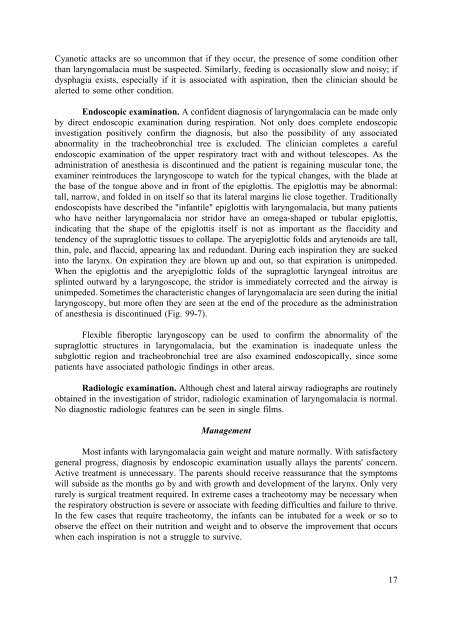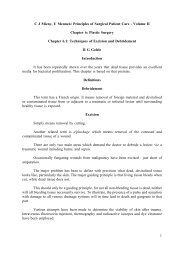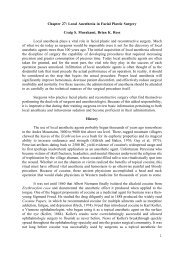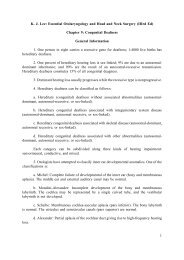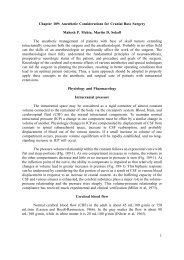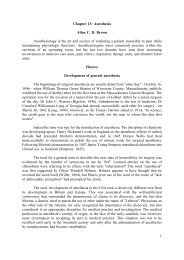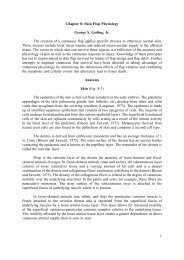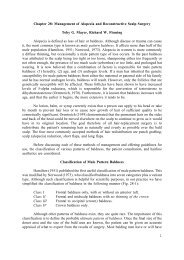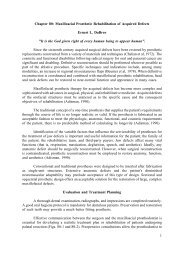1 Chapter 99: Congenital Disorders of the Larynx ... - Famona Site
1 Chapter 99: Congenital Disorders of the Larynx ... - Famona Site
1 Chapter 99: Congenital Disorders of the Larynx ... - Famona Site
You also want an ePaper? Increase the reach of your titles
YUMPU automatically turns print PDFs into web optimized ePapers that Google loves.
Cyanotic attacks are so uncommon that if <strong>the</strong>y occur, <strong>the</strong> presence <strong>of</strong> some condition o<strong>the</strong>r<br />
than laryngomalacia must be suspected. Similarly, feeding is occasionally slow and noisy; if<br />
dysphagia exists, especially if it is associated with aspiration, <strong>the</strong>n <strong>the</strong> clinician should be<br />
alerted to some o<strong>the</strong>r condition.<br />
Endoscopic examination. A confident diagnosis <strong>of</strong> laryngomalacia can be made only<br />
by direct endoscopic examination during respiration. Not only does complete endoscopic<br />
investigation positively confirm <strong>the</strong> diagnosis, but also <strong>the</strong> possibility <strong>of</strong> any associated<br />
abnormality in <strong>the</strong> tracheobronchial tree is excluded. The clinician completes a careful<br />
endoscopic examination <strong>of</strong> <strong>the</strong> upper respiratory tract with and without telescopes. As <strong>the</strong><br />
administration <strong>of</strong> anes<strong>the</strong>sia is discontinued and <strong>the</strong> patient is regaining muscular tone, <strong>the</strong><br />
examiner reintroduces <strong>the</strong> laryngoscope to watch for <strong>the</strong> typical changes, with <strong>the</strong> blade at<br />
<strong>the</strong> base <strong>of</strong> <strong>the</strong> tongue above and in front <strong>of</strong> <strong>the</strong> epiglottis. The epiglottis may be abnormal:<br />
tall, narrow, and folded in on itself so that its lateral margins lie close toge<strong>the</strong>r. Traditionally<br />
endoscopists have described <strong>the</strong> "infantile" epiglottis with laryngomalacia, but many patients<br />
who have nei<strong>the</strong>r laryngomalacia nor stridor have an omega-shaped or tubular epiglottis,<br />
indicating that <strong>the</strong> shape <strong>of</strong> <strong>the</strong> epiglottis itself is not as important as <strong>the</strong> flaccidity and<br />
tendency <strong>of</strong> <strong>the</strong> supraglottic tissues to collape. The aryepiglottic folds and arytenoids are tall,<br />
thin, pale, and flaccid, appearing lax and redundant. During each inspiration <strong>the</strong>y are sucked<br />
into <strong>the</strong> larynx. On expiration <strong>the</strong>y are blown up and out, so that expiration is unimpeded.<br />
When <strong>the</strong> epiglottis and <strong>the</strong> aryepiglottic folds <strong>of</strong> <strong>the</strong> supraglottic laryngeal introitus are<br />
splinted outward by a laryngoscope, <strong>the</strong> stridor is immediately corrected and <strong>the</strong> airway is<br />
unimpeded. Sometimes <strong>the</strong> characteristic changes <strong>of</strong> laryngomalacia are seen during <strong>the</strong> initial<br />
laryngoscopy, but more <strong>of</strong>ten <strong>the</strong>y are seen at <strong>the</strong> end <strong>of</strong> <strong>the</strong> procedure as <strong>the</strong> administration<br />
<strong>of</strong> anes<strong>the</strong>sia is discontinued (Fig. <strong>99</strong>-7).<br />
Flexible fiberoptic laryngoscopy can be used to confirm <strong>the</strong> abnormality <strong>of</strong> <strong>the</strong><br />
supraglottic structures in laryngomalacia, but <strong>the</strong> examination is inadequate unless <strong>the</strong><br />
subglottic region and tracheobronchial tree are also examined endoscopically, since some<br />
patients have associated pathologic findings in o<strong>the</strong>r areas.<br />
Radiologic examination. Although chest and lateral airway radiographs are routinely<br />
obtained in <strong>the</strong> investigation <strong>of</strong> stridor, radiologic examination <strong>of</strong> laryngomalacia is normal.<br />
No diagnostic radiologic features can be seen in single films.<br />
Management<br />
Most infants with laryngomalacia gain weight and mature normally. With satisfactory<br />
general progress, diagnosis by endoscopic examination usually allays <strong>the</strong> parents' concern.<br />
Active treatment is unnecessary. The parents should receive reassurance that <strong>the</strong> symptoms<br />
will subside as <strong>the</strong> months go by and with growth and development <strong>of</strong> <strong>the</strong> larynx. Only very<br />
rarely is surgical treatment required. In extreme cases a tracheotomy may be necessary when<br />
<strong>the</strong> respiratory obstruction is severe or associate with feeding difficulties and failure to thrive.<br />
In <strong>the</strong> few cases that require tracheotomy, <strong>the</strong> infants can be intubated for a week or so to<br />
observe <strong>the</strong> effect on <strong>the</strong>ir nutrition and weight and to observe <strong>the</strong> improvement that occurs<br />
when each inspiration is not a struggle to survive.<br />
17


